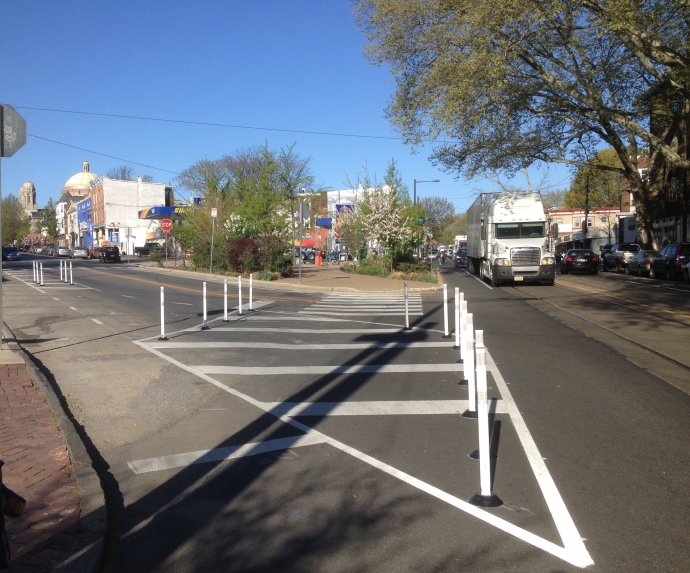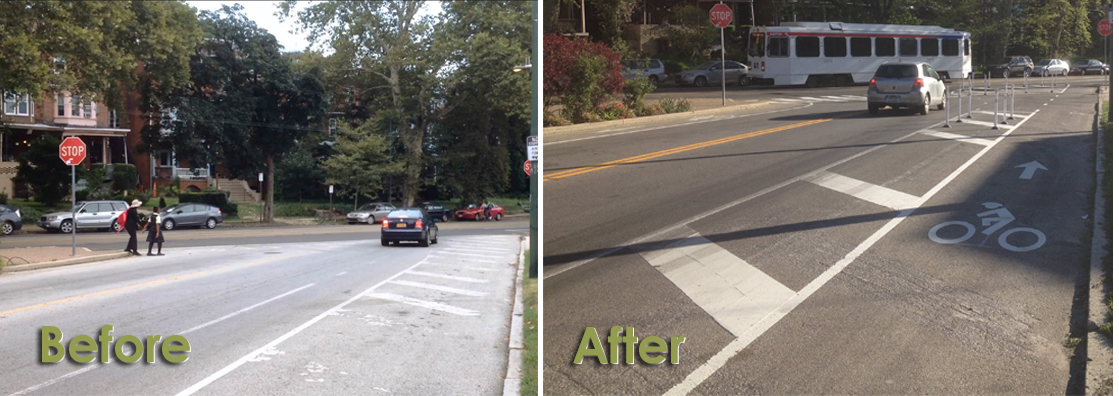
Visitors / Employees
Dangerous Intersection at Baltimore & Springfield Gets a Makeover

The intersection of Baltimore Ave. & Springfield Ave. has long been one of the most uncomfortable and dangerous crossings in University City for pedestrians and bicyclists. Fortunately, based on community input and following close study of the intersection the City of Philadelphia’s Mayor’s Office of Transportation and Utilities (MOTU) and the Streets Department have made changes that will greatly improve the intersection for all users. Vehicle lanes have been reconfigured, and new buffered crosswalks and bike lanes were painted and protected by flexible delineator posts. The new, protected on-street bike lane is the first to be installed in Philadelphia.
Conversations to transform the intersection date back nearly a decade, but a recent push was initiated by Seth Budick, University City District’s Policy and Research Manager. He approached MOTU about the possibility of implementing pedestrian and bicyclist safety improvements similar to those at the pedestrian plazas UCD has completed in other locations.
 “I walk out of my way to avoid that intersection every morning,” Budick says, “even though it’s the most direct way to take my daughter to preschool. It’s unpleasant and dangerous.”
“I walk out of my way to avoid that intersection every morning,” Budick says, “even though it’s the most direct way to take my daughter to preschool. It’s unpleasant and dangerous.”
The location was among those identified in University City where it made sense to reallocate pavement from vehicles to pedestrians by creating a physically delineated, buffered space, but not necessarily a new activated public plaza like the one at Woodland Green. MOTU had also been looking at ways to improve the intersection, and UCD helped facilitate a conversation between the City and the nearby HMS School, who had to agree to the changes since it affected traffic patterns into their parking lot.
Thanks to MOTU and the Streets Department’s interventions, instead of converging at an acute angle, Baltimore and Springfield now intersect at a standard 90° angle, slowing vehicle speeds, prompting them to come to a complete stop, and improving their visibility as they turn. Crossing distances are also dramatically reduced for pedestrians, and the new protected bike lane gives bicyclists a clearly demarcated path from Springfield to Baltimore. We anticipate these changes to significantly increase the walkability of the neighborhood.
In the comments below, we've posted two videos of the intersection before and after the improvements. In the first video shot before the improvements, notice how cautious the pedestrians are to cross, and how the left-turning vehicles veer into the wrong lane. The second video, shot on April 30, shows a pedestrian quickly reaching the protected area.


